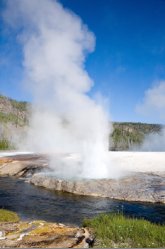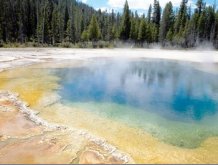How Close is the Yellowstone SuperVolcano to Blowing its Lid? (And How Would it Impact Us?)
by www.SixWise.com
Every year, millions of visitors are drawn to Yellowstone
National Park to take in its breathtaking scenery and surreal
hot springs, steam vents and geysers. What many may not know,
however, is that the very activity that makes Yellowstone
so magnificent is caused by an active, underground volcano
system -- one of the world's largest.
|

Yellowstone National Park's 10,000 thermal features
are caused by the supervolcano below its surface.
|
In some areas, partially molten rock is gurgling just a few
miles below the surface, contributing to Yellowstone's characteristic
steam vents, mud pots and over 10,000 thermal features. Meanwhile,
every year there are active ground deformations and anywhere
from 1,000 to 3,000 earthquakes of varying magnitudes occur
at the park, making it quite obvious that geologic forces
are still very active.
"Yellowstone is much larger than any other volcanic
feature in North America," says geophysicist Bob Smith
of the Yellowstone Volcano Observatory and the University
of Utah in a Discovery Channel report. "People don't
realize this."
The Yellowstone SuperVolcano: Could it Erupt?
According to the Yellowstone Volcano Observatory (YVO), which
was formed by the U.S. Geological Survey, the University of
Utah, and Yellowstone National Park to continually monitor
volcanic activity in the park, there have been three extremely
large explosive eruptions at Yellowstone in the past 2.1 million
years.
During these eruptions, the most recent of which occurred
about 640,000 years ago, a layer of ash covered half of North
America and chemicals and ash were blown around the planet,
causing a notable decrease in temperatures worldwide.
So far, Yellowstone has had gigantic eruptions about once
every 600,000 to 800,000 years. Since it's been about 640,000
years since the last one, this theoretically means there could
be a catastrophic eruption at any time.
As it stands, scientists from YVO monitoring Yellowstone
say it's extremely unlikely that a huge eruption will occur
in this century or even millennium, however, they expect that
Yellowstone will erupt at some point in the future.
What if Yellowstone Did Erupt?
The most likely type of eruption that will occur at Yellowstone
is a hydrothermal eruption of steam or hot water that could
blast out shallow craters.
|

The volcanic crater beneath Yellowstone, called a "caldera,"
is about 1,500 square miles.
|
At the next level would be a smaller volcanic eruption that
could produce significant volumes of volcanic ash, pumice
and lava, similar in magnitude to the 1980 eruption of Mt.
St. Helens or the, much larger, 1991 Mount Pinatubo eruption.
In the worst-case scenario would be an eruption similar to
those that occurred 2.1 million, 1.3 million, and 640,000
years ago. An eruption of this magnitude could be devastating
not just to North America but to the entire world.
"An area the size of North America can be devastated,
and pronounced deterioration of global climate would be expected
for a few years following the eruption," said Stephen
Self of Open University in the United Kingdom about super-eruptions.
"They could result in the devastation of world agriculture,
severe disruption of food supplies, and mass starvation. These
effects could be sufficiently severe to threaten the fabric
of civilization."
The most recent super-eruption actually occurred about 74,000
years ago in what is now Sumatra. The volcano, Toba, erupted
with 10,000 times the force of Mount St. Helens and spewed
out enough ash to darken the sky worldwide and, according
to scientists, nearly drove humans to extinction.
And while YVO researchers stress that this type of super-eruption
isn't coming any time soon, the volcanic activity going on
beneath Yellowstone is too large to ignore. As YVO monitors
the park, they say they'd be able to detect a catastrophic
eruption anywhere from weeks to years before it occurred,
and would be tipped off by strong earthquake swarms, rapid
ground deformation and other intense precursory activity.
Should an eruption be detected, they say, nothing much could
be done.
"The temperatures, pressures, physical characteristics
of partially molten rock, and the immensity of the magma chamber
are beyond man's ability to influence -- much less control,"
says YVO.
Meanwhile, British researchers are suggesting that emergency
management agencies give some thought to how to handle such
an emergency.
"We don't want to be sensationalist about this, but
it's going to happen. We just can't say exactly when,"
Self said.
Recommended Reading
The
5 Great National Parks Almost No One Knows About
'Killer
Asteroid Slams into the Earth!' How Likely is This Headline?
Sources
Yellowstone
Volcano Observatory
Discovery
Channel
LiveScience.com
BBC
News